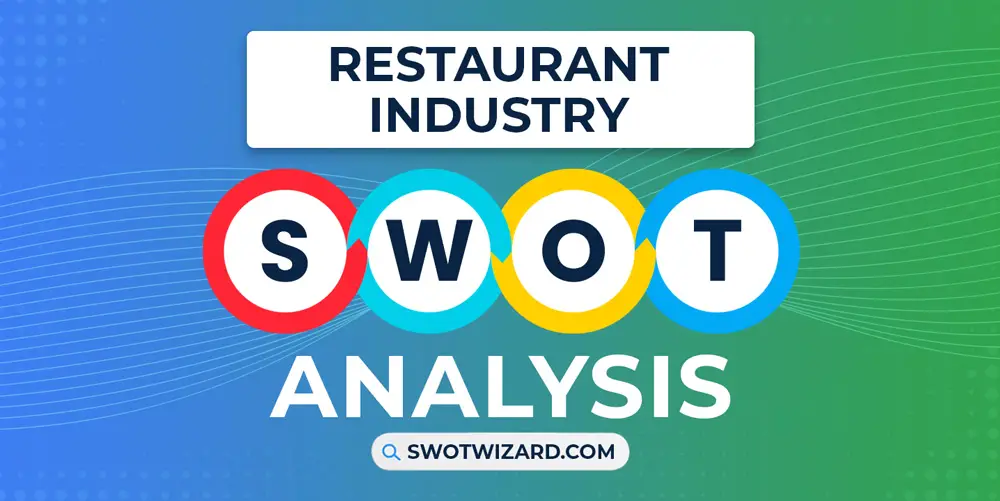The restaurant industry has become a dynamic global phenomenon synonymous with the vibrant tapestry of culinary artistry and hospitality. From humble beginnings to diverse culinary experiences, it embodies cultural fusion, innovation, and a unique blend of flavors that we will learn in this restaurant industry SWOT analysis.
Restaurant Industry Overview
The term “restaurant” originates from the French word “restaurer,” meaning “to restore” or “to refresh.” Many great restaurants exist, but “Botin” in Madrid, Spain, holds the Guinness World Record as the world’s oldest restaurant, established in 1725 and still serving customers today.
And from there, the restaurant industry has become one of the largest employers globally, providing jobs to millions of people, and the global restaurant industry was estimated to be worth over $1.5T in 2022.
Competitors in Restaurant Industry
McDonald’s | Chipotle | Domino’s Pizza | Wendy’s | Subway | KFC | Burger King | Pizza Hut | Dunkin Donuts | Taco Bell
Did You Know?
Contrary to popular belief, fortune cookies are not originally from China. They were created in early 20th-century California and have since become synonymous with Chinese cuisine.
Strengths – Restaurant Industry SWOT Analysis

Diversified Offerings: The industry has changed a lot in the last two decades, especially the past two years, and touched every type of offerings it can offer, and it boasts a rich tapestry of culinary experiences, from fine dining to street food. A single street can house Italian restaurants, Asian fusion spots, and vegan cafes, amplifying customer choices.
Growing Demand: The evergreen appetite for dining out remains unwavering, driven by changing lifestyles and social trends. According to the data, restaurant sales in the USA alone reached a staggering $898B in 2022, showcasing a consistent appetite for dining experiences. Besides, sales are projected to reach $1.2T by 2030, with a 1.1% growth rate.
Skilled Personnel: The sector’s appeal lies in its ability to attract skilled chefs, waitstaff, and managers, pivotal in delivering exceptional culinary experiences. The prestigious “WorldSkills” competition showcases the caliber of talent cultivated in culinary and service fields, not to mention all the millions of people who never went to any culinary institute, yet creating and serving billions of people worldwide.
Location & Services: Strategic placement in bustling urban hubs and tourist hotspots contributes to foot traffic. Waterfront or city-center setups, like Sydney’s harborside dining, captivate diners and capitalize on tourism. Moreover, diverse service formats such as takeout and delivery accommodate varied preferences, exemplified by fast-casual chains.
Weaknesses – Restaurant Industry SWOT Analysis
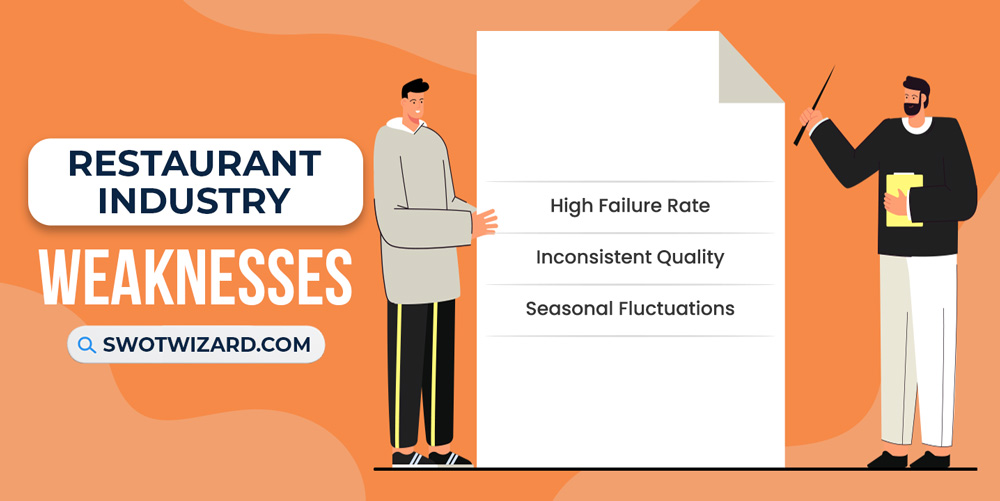
High Failure Rate: As thrilling and amazing as the entire industry might sound, the failure rate is also competitively high. According to various stats and data, over sixty percent of restaurants don’t work out just after one year of operations, which can be scary yet true. And behind this high failure rate, there are multiple reasons, such as underestimating costs, lack of market understanding, or poor location choice.
Inconsistent Quality: The entire business model relies on both excellent product quality and amazing service, and maintaining both constantly remains a challenge. According to many surveys in the last few years, over 60% of diners expect the same quality on every visit but aren’t satisfied because of inconsistent quality. Besides, another study shows that over 78% of diners wouldn’t return to a restaurant after a single bad experience, emphasizing the need for unwavering quality.
Seasonal Fluctuations: The industry is susceptible to seasonal variations, impacting revenue, growth rate, and overall cash flow situation. If we look at the data, beachside restaurants may thrive in summer but struggle during colder months, and it can lead to a 20-30% drop in sales. On the other hand, if you just look around, you will notice that ice cream parlors often witness a slump in colder months, causing a dip in earnings by a massive number compared to summer.
Opportunities – Restaurant Industry SWOT Analysis
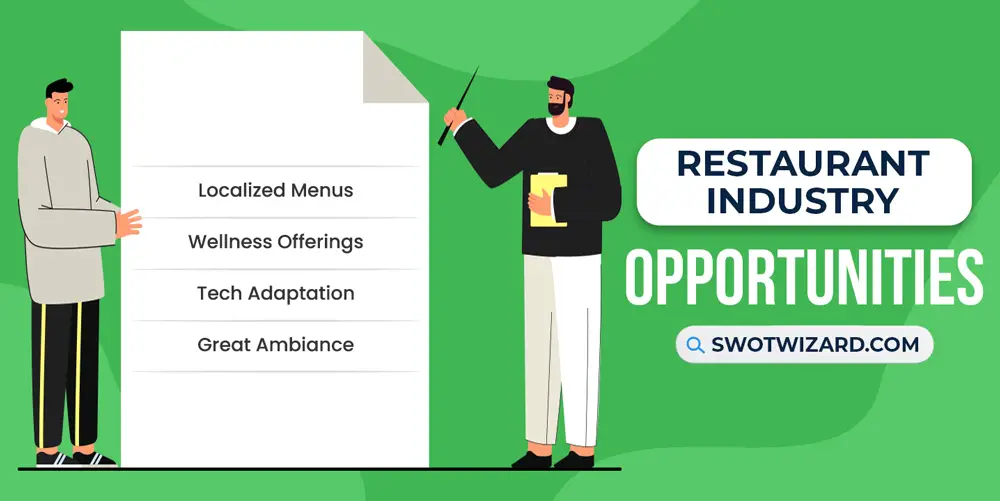
Localized Menus: Tailoring menus to reflect local flavors can establish a unique culinary identity and foster a strong customer connection. From small restaurants to fast food chains, everyone is doing it now, and McDonald’s ‘McAloo Tikki‘ in India resonates with local tastes and Starbucks’ regional coffee variations across countries, like the Matcha Latte in Japan. Similarly, by offering localized food, Central became the most successful restaurant.
Wellness Offerings: Capitalizing on the health-conscious trend, restaurants can feature nutritious options, and it’s a good practice attracting a new kind of crowd in the restaurants. Many case studies show that offering a balanced and salad-centric menu can increase revenue, aligning with the growing demand for wholesome choices. And according to data, the market has been growing at a 5.5% rate.
Tech Adaptation: The world has been smaller after the pandemic, and instead of going out, people started ordering food online. Not just that, many preferences changed, and one of the crucial in the restaurant industry is tech adaptation and automation. And again, a great UI increases customer engagement and enhances customer convenience. Not just that, the ordering and delivery have decreased, but also there are new options such as offerings in dine-in.
Great Ambiance: Most restaurants these days can offer great food but not amazing ambiance, which can be a differentiating point for the restaurants. All the great restaurants in the world have two things in common, they offer great food and ambiance. As a result, these can increase foot traffic, customer engagement, and retention rate.
Threats – Restaurant Industry SWOT Analysis
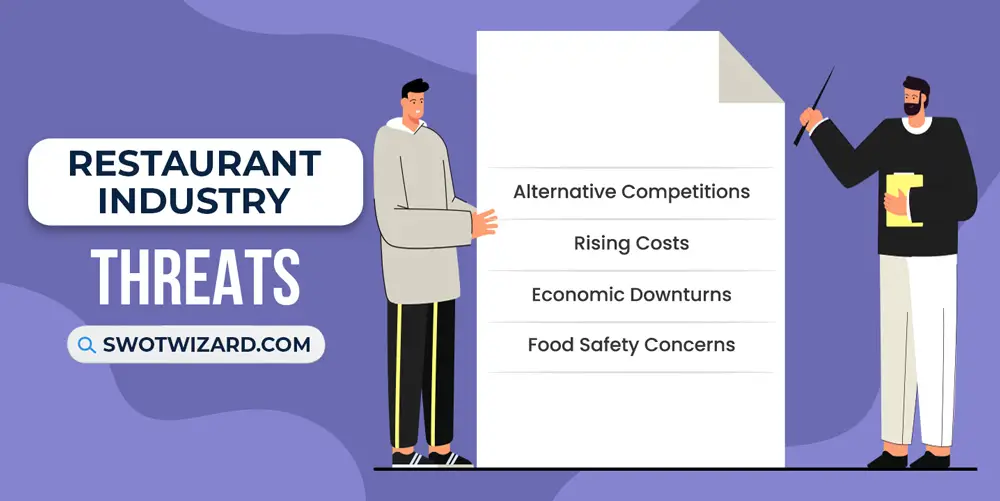
Alternative Competitions: The emergence of food delivery apps and cloud kitchens challenges traditional dine-in models. The entire competition scenario has changed after the pandemic, and there is no other way but to adapt to the new trends like food trucks, meal kit delivery services, and virtual kitchens.
Rising Costs: Because of the global recession, and massive inflation, the cost of everything is rising, including ingredients, labor, and rent expenses in the restaurant industry. According to multiple sources, food costs have increased by nearly 25% over the past decade. Besides, labor shortages have led to wage hikes, straining budgets, and eroding profit margins.
Economic Downturns: During the 2008 financial crisis, restaurant sales in the USA dropped by 1.2%, which is very concerning as the world is going through major inflation and downturns. After that, in 2020, the industry suffered a $240B loss in sales, highlighting the sector’s susceptibility to downturns and consumer spending cutbacks.
Food Safety Concerns: There are tons of incidents about food safety, and it has become quite repetitive and frightening for the general people. High-profile foodborne illnesses, like the Chipotle E. coli outbreak in 2015, damaged reputations and led to temporary closures, underscoring the industry’s vulnerability to public health crises.
[Bonus Infographic] SWOT Analysis of Restaurant Industry
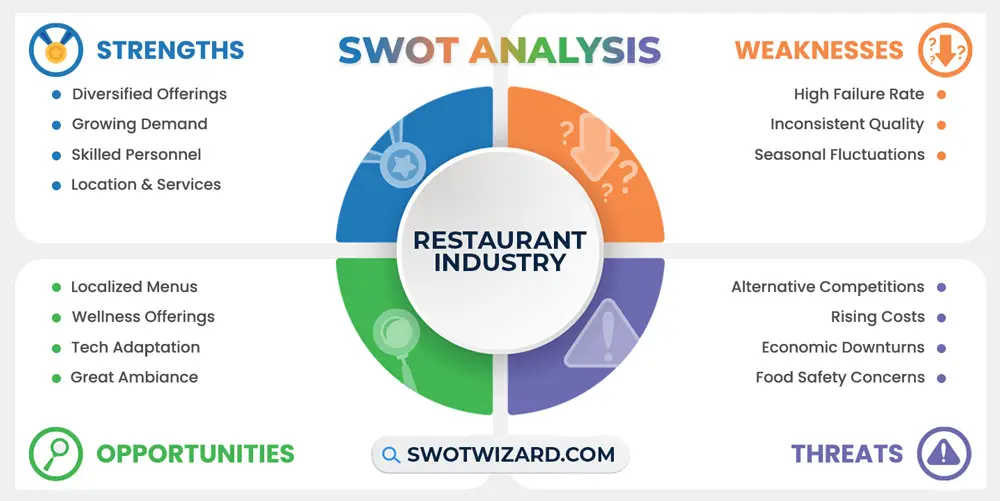
Recommendations for Restaurant Industry
The restaurant industry has changed so much in the last decade that it’s beyond our imagination. And here are some recommendations for them.
- Highlight regional specialties and collaborate with local suppliers to foster a sense of authenticity.
- Introduce a dedicated and balanced section for nutritious dishes.
- Embrace technology to enhance customer engagement and streamline operations in the overall system, both dine-in and delivery services.
- Thoughtfully design interior spaces, incorporating aesthetic elements that resonate with your target audience.
Frequently Asked Questions (FAQs)
What is the biggest restaurant business?
The biggest restaurant business is McDonald's.
What are the categories of the restaurant market?
The categories of the restaurant market are QSR, FCR, CDR, and FDR.
Final Words on Restaurant Industry SWOT Analysis
The restaurant industry’s dynamic landscape presents both opportunities and challenges. Adapting to changing consumer preferences, embracing technology, ensuring food safety, and creating memorable experiences are key to sustained success. Navigating these facets with innovation and resilience will determine the industry’s enduring impact on culinary culture.
References
- Reiley, L. (2022, December 26). How the pandemic altered the restaurant industry forever. The Washington Post.
- Diners craving value as restaurant industry rebounds. (2023, June 22). FastCasual.
- Tech Tracker: Automation has become the biggest selling point of restaurant technology. (2023, August 16). Nation’s Restaurant News.
- Kelso, A. (2021, January 26). U.S. Restaurant Industry Finished The Year $240 Billion Below Pre-Pandemic Sales Estimates. Forbes.

